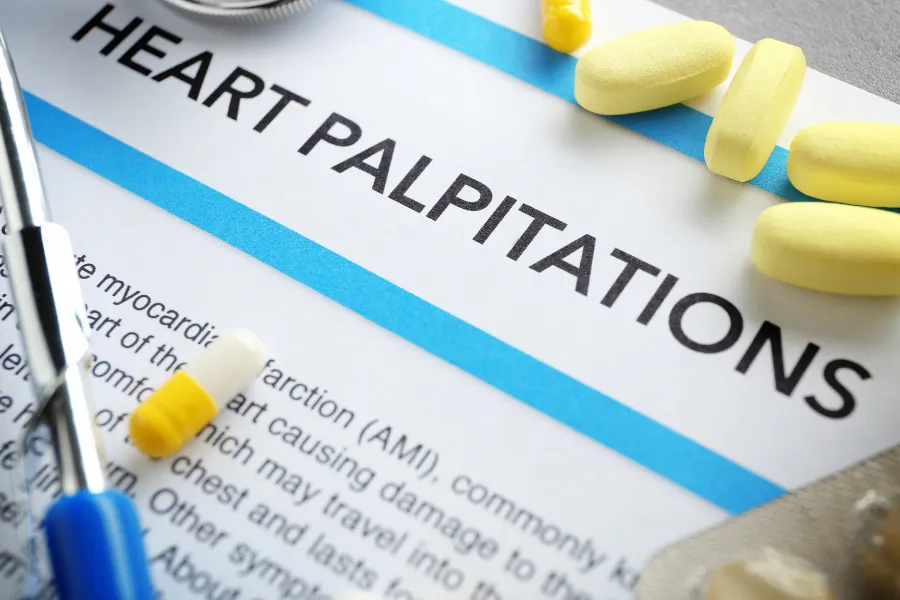What are palpitations?
Understanding, Evaluation, and Reassurance
Palpitations, though common, generally do not signal a serious underlying condition. These sensations can be extra beats, rapid rhythms, irregular patterns, jumping sensations, or even a perception of missed beats. Frequently, patients I encounter have been attributed with anxiety as the root cause, yet I find this approach less than helpful when addressing their concerns. I typically explain to patients that while anxiety can indeed trigger palpitations, these sensations often originate from specific sources, such as ectopic beats. It’s important to note that anxiety can exacerbate or amplify these underlying triggers.
Attributing all palpitations to anxiety alone can be dismissive and oversimplified. While anxiety can certainly play a role, it’s essential to recognize that these sensations often have distinct origins that deserve thorough evaluation and consideration.
Palpitations can understandably alarm patients and evoke feelings of anxiety about their health. This reaction is a normal facet of human nature, as we naturally become concerned when our bodies display irregularities. To address these concerns, my approach involves conducting preliminary tests to ensure that we comprehensively evaluate the situation and rule out any potential arrhythmic causes.
By taking this systematic and reassuring approach, we can offer patients and their families a sense of comfort and clarity. It’s rewarding to witness the relief that stems from understanding the root causes of palpitations and the steps taken to ensure a thorough evaluation. Ultimately, by providing this personalized reassurance and embracing a comprehensive workflow, we can significantly enhance the well-being and peace of mind of those experiencing palpitations.
Exploring the Rhythmic Origins: A Closer Look at Palpitation Triggers
I find it crucial to delve into the root causes that might be behind palpitations, particularly if they are persisting. This can often be accomplished through a thorough history-taking, comprehensive examination, and evaluation of relevant family medical history alongside initial tests. It’s worth noting that many of these underlying triggers are physiological or relatively benign, and simple reassurance and attention to a few lifestyle factors can lead to prompt resolution.
As we navigate this process, we unearth the underlying factors that can lead to swift or irregular heartbeats, ultimately giving rise to the sensations recognized as palpitations. This exploration offers a clearer understanding of the core contributors to these encounters, allowing us to gain valuable insights into the origins of palpitations and the factors lying beneath.
-
Physiological Sinus Tachycardia: A normal response to physical activity, emotions, or stress that increases heart rate. This can lead to palpitations, especially during exercise or moments of heightened emotion. Tachycardia is defined as a heart rate of > 100bpm.
-
Atrial Ectopics: These are premature beats originating in the atria (upper chambers of the heart). They can create a sensation of fluttering or skipped beats.
-
Ventricular Ectopics: Premature beats arising from the ventricles (lower heart chambers). They might cause a sensation of thumping or a brief pause in the heartbeat.
-
Supraventricular Tachycardia (SVT): Rapid heart rates due to abnormal electrical pathways in the heart. Patients often experience a sudden onset of palpitations. For additional details on SVT, please visit our YouTube video through this link.
-
Atrial Fibrillation (AF): Irregular, rapid heart rhythm originating in the atria. This can create a quivering sensation and a rapid heartbeat.
-
Atrial Flutter: A regular but rapid heart rhythm originating in the atria. It can cause palpitations accompanied by a sensation of a fast, steady beat.
-
Ventricular Bigeminy: Alternating normal beats with premature ventricular contractions (PVCs). The pulse might seem slow because of the irregular rhythm, raising concerns.
-
Runs of Ventricular Tachycardia (VT): Periods of abnormally fast ventricular rhythm that can lead to palpitations, dizziness, and fainting. This is a condition that requires prompt attention to evaluate underlying causes and the best treatment.
-
Inappropriate Sinus Tachycardia: An excessively fast heart rate during normal activities, leading to palpitations and discomfort.
-
Wolff-Parkinson-White Syndrome (WPW): An extra electrical pathway can cause rapid heart rates and palpitations, often accompanied by anxiety.
It’s important to note that the rhythm disorders mentioned are not an exhaustive list; your doctor can provide you with a tailored assessment. Each rhythm disorder has distinct characteristics and potential symptoms. Accurate diagnosis through medical evaluation is essential to providing proper management and alleviating concerns.

The thyroid gland in the neck can play a significant role in heart health. Disorders like hyperactive thyroid (hyperthyroidism) can lead to persistent rapid heart rate (sinus tachycardia) and an increased risk of atrial fibrillation, often presenting with palpitations
Common palpitation triggers
Palpitations can arise from various sources, triggering a range of sensations that individuals find disconcerting. Understanding these underlying causes is essential for both patients and healthcare practitioners. Here are some prevalent factors that contribute to palpitations:
-
Stress and Anxiety: Emotional stress and anxiety can trigger a surge of adrenaline and other stress hormones, leading to palpitations. The body’s “fight or flight” response can cause the heart to race or flutter.
-
Caffeine and Stimulants: Excessive consumption of caffeine, present in coffee, tea, energy drinks, and some medications, can accelerate heart rate and provoke palpitations.
-
Physical Exertion: Engaging in intense physical activities, especially if unfamiliar with them, can elevate heart rate and induce palpitations.
-
Nicotine: Smoking and other forms of nicotine consumption stimulate the heart and can lead to irregular heartbeats and palpitations.
-
Medical Conditions: Underlying medical issues such as thyroid disorders, anemia, and electrolyte imbalances can disrupt normal heart rhythm, resulting in palpitations. Another common condition is obstructive sleep apnea (OSA), a sleep disorder characterized by repeated pauses in breathing during sleep.
-
Heart Conditions: Various heart conditions, including arrhythmias (abnormal heart rhythms), heart valve abnormalities, and coronary artery disease, can cause palpitations. These conditions disrupt the heart’s electrical system, leading to irregular beats.
-
Medications: Certain medications, such as decongestants, asthma inhalers, and certain over-the-counter cold remedies, contain stimulants that might trigger palpitations in susceptible individuals.
-
Hormonal Changes: Hormonal fluctuations during menstruation, pregnancy, and menopause can influence heart rate and rhythm, occasionally leading to palpitations.
-
Substances and Illicit Drugs: The use of certain substances and illicit drugs can profoundly affect heart rhythm and lead to palpitations.
-
Fever and Dehydration: Elevated body temperature due to fever or dehydration can affect heart rate and trigger palpitations.
-
Digestive Issues: Gastroesophageal reflux disease (GERD) and other digestive problems can create sensations that individuals might confuse with palpitations.
Understanding these diverse triggers for palpitations is crucial for accurate diagnosis and effective management. By identifying the root cause, healthcare professionals can recommend appropriate interventions and lifestyle adjustments that alleviate or eliminate palpitations, allowing individuals to lead healthier, more comfortable lives.

Addressing palpitations
Experiencing palpitations can be troublesome; sometimes, the triggers might not be immediately obvious. While simple lifestyle measures can often help alleviate palpitations, it’s important to consider other potential underlying factors that might be overlooked. Here are some practical steps to manage palpitations and uncover hidden triggers:
-
Stay Hydrated: Adequate hydration supports heart health and can prevent palpitations triggered by dehydration.
-
Adopt a Balanced Diet: A nutritious diet promotes overall heart function. Be mindful of potential triggers in your diet, like excessive caffeine or sugary foods.
-
Consider Magnesium: Under medical supervision, magnesium supplements might aid in managing palpitations.
-
Manage Stress: Stress reduction techniques like deep breathing and meditation can help manage both stress and palpitations.
-
Regular Physical Activity: Exercise supports heart health and can help regulate heart rate. Consult your healthcare provider before starting a new exercise routine.
-
Caffeine Moderation: If you suspect caffeine triggers your palpitations, moderate your intake and observe any changes.
-
Avoid Tobacco and Alcohol: Both can provoke palpitations; minimizing or avoiding them can be beneficial.
-
Adequate Sleep: Quality sleep is essential for heart health. Conditions like obstructive sleep apnea, often unnoticed, can contribute to palpitations.
-
Medical Guidance: Consult a healthcare provider before making significant lifestyle changes. They can help uncover hidden triggers and provide personalized guidance.
-
Address Other Conditions: Conditions like obstructive sleep apnea, often overlooked, can cause palpitations. If you suspect an underlying condition, seek medical evaluation.
In certain scenarios, your healthcare provider might contemplate introducing medications to assist. Here’s a brief overview of potential medication options:
-
Beta Blockers: These medications help regulate heart rate and reduce the force of contractions. They are commonly prescribed for conditions like atrial fibrillation, as they can help control rapid heart rhythms.
-
Calcium Channel Blockers: These medications work by relaxing and widening blood vessels, reducing the heart’s workload and oxygen demand. They are used to treat various heart conditions, including certain types of arrhythmias.
-
Antiarrhythmics: These medications are designed to restore or maintain normal heart rhythm. They are often used for more complex arrhythmias and can be tailored to the specific rhythm disorder.
-
Other Medications: Depending on the cause of your palpitations, your healthcare provider may recommend other medications that target specific triggers or contributing factors.
By addressing simple measures and considering potential hidden triggers, you can work toward managing and potentially reducing palpitations. Consulting with a healthcare provider is crucial for a comprehensive evaluation, especially if you suspect an underlying condition. You can navigate palpitations more effectively and enhance your heart health with informed guidance.
Conclusions
In conclusion, palpitations can be a concerning symptom, but they can often be effectively treated with proper diagnosis and management. If you are experiencing palpitations, it is important to seek medical attention to identify the underlying cause and develop a treatment plan that works for you. By working closely with your doctor and making lifestyle changes as needed, you can help manage your symptoms and ensure the health of your heart.




